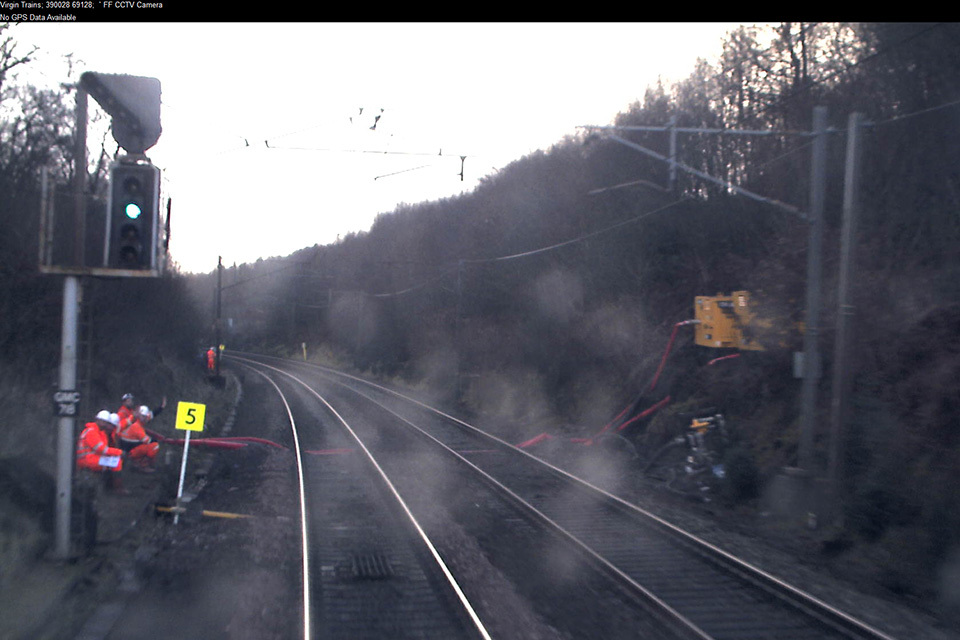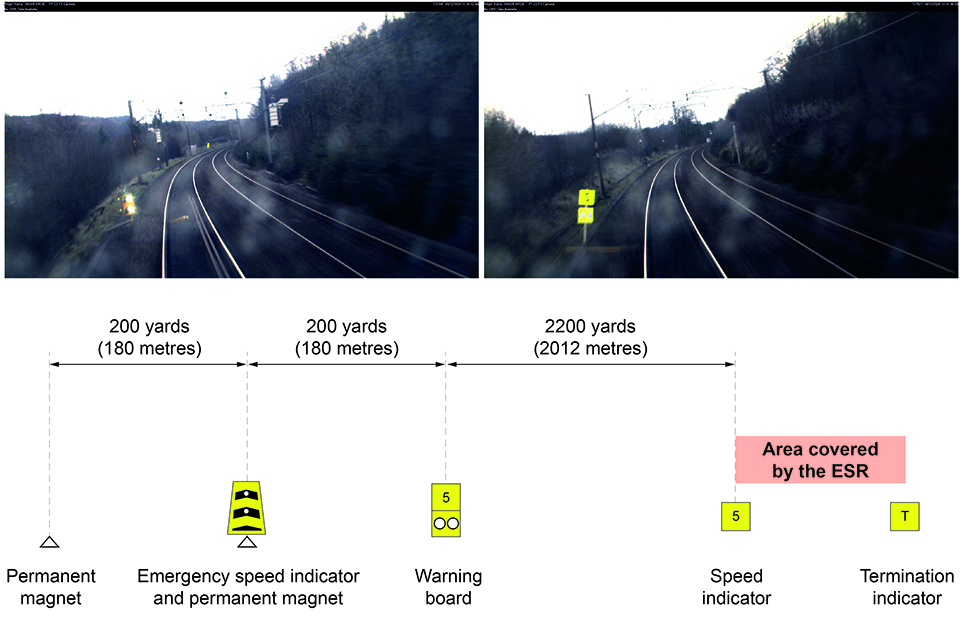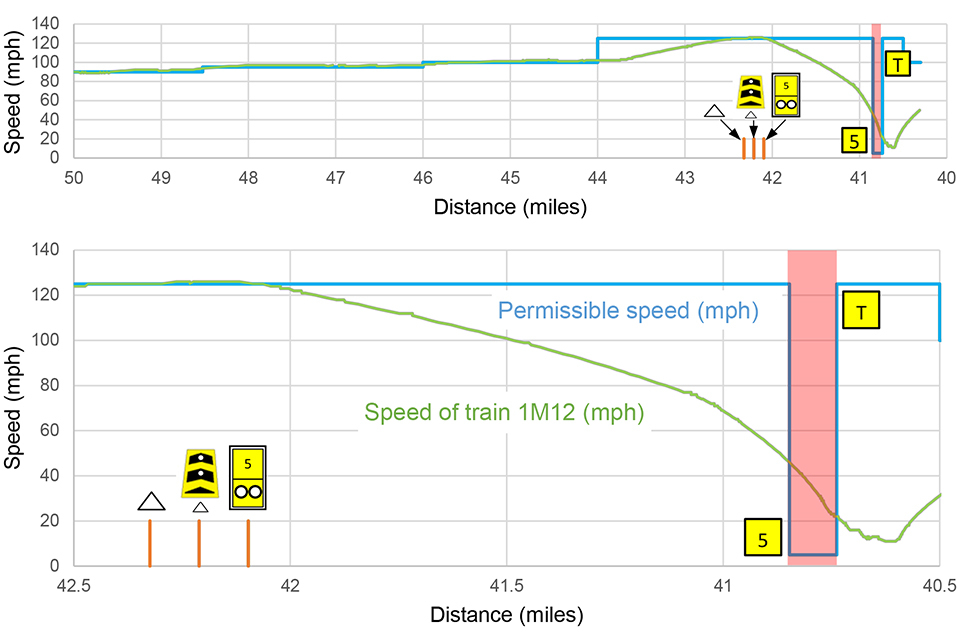Overspeed through an emergency speed restriction near Beattock, Dumfries and Galloway, 20 December 2020
Published 24 March 2021
1. Important safety messages
This incident demonstrates the importance of:
-
Trackside equipment giving adequate warning of speed restrictions ahead and accounting for the highest permissible speed of approach and the prevailing track gradient. The use of estimated or nominal braking distances can result in trains having inadequate time to slow down before they enter a speed restriction.
-
Network Rail complying with its company standard NR/L3/TRK/7006 in a timely manner, so that the intended placement of equipment for emergency speed restrictions is checked by a person who is certified as competent before the equipment is installed.
2. Summary of the incident
At about 12:25 hrs on 20 December 2020, train 1M12, the 11:35 hrs passenger service from Glasgow Central to London Euston, entered a 5 mph (8 km/h) emergency speed restriction (ESR) located near Beattock, on the up line of the West Coast main line, while travelling at about 45 mph (72 km/h). The train, operated by Avanti West Coast, then travelled through the ESR above the required maximum speed. The ESR had been put in place because of an earlier embankment failure.
The driver of train 1M12 reported the incident to the signaller, who contacted maintenance staff working at the site. They confirmed that the train had been going too fast when it passed them, but that this had not affected the condition of the embankment or track.
When reporting the incident to the signaller, the driver of train 1M12 stated that the distance between the warning board for the ESR and the speed indicator, showing the start of the ESR, was too short. The signaller asked the driver of the next train to check the speed restriction signage, and they subsequently reported back that it was all in place and they were able to slow down in time to comply with the ESR. Subsequent investigations by Network Rail established that the distance between the ESR’s warning board and the start of the ESR was too short for trains that could approach the ESR at 125 mph (201 km/h).

Forward-facing CCTV image from train 1M12 showing the speed indicator at the start of the ESR
3. Cause of the incident
Following very heavy rainfall in the Beattock area during the evening and night of 18/19 December 2020, Network Rail track maintenance staff found that a culvert about one mile (1.6 km) north of Beattock was overwhelmed by flood water and about 250 to 300 yards (230 to 275 metres) of track was flooded. Network Rail immediately stopped any trains from passing through the affected area, closing the West Coast main line.
Maintenance staff subsequently found that the culvert was blocked and that the flow of water down the track had caused the embankment on the east side of the line to fail over a length of about 15 metres, at 40 miles 1400 yards. A previous failure had occurred in the same place in December 2013. After this earlier failure, Network Rail had fitted monitoring equipment to the track running alongside the top of this section of embankment. However, it did not receive any alarms from this monitoring equipment as the track had not been affected by this latest embankment failure.

The section of embankment that was washed away by the flood water
On 19 December, Network Rail arranged for contract staff to go to the site and throughout the day these staff used pumps to remove flood water and began to unblock the culvert. They also removed debris that had washed onto the track. Specialist staff attended and assessed the state of the embankment. They agreed that the West Coast main line could be reopened at this location subject to an ESR of 20 mph (32 km/h) on the down line and an ESR of 5 mph (8 km/h) on the up line. Both speed restrictions were 190 yards (174 metres) long, covering the length of the embankment failure and extending either side of it.
By 21:05 hrs, Network Rail staff had put the trackside equipment for these ESRs in place. As well as the boards, this equipment included permanent magnets placed between the rails. These actuate the automatic warning system fitted to the train as it passes over each magnet, and cause a horn to sound in the cab. This alerts the driver to the upcoming ESR, and they must press a button to acknowledge the warning or the train’s brakes will be automatically applied. Once this equipment was in place there was no longer a requirement for the signaller to stop and caution trains approaching these speed restrictions. Network Rail also emailed the details of the ESRs to the affected train operating companies.

The layout of the trackside equipment for the ESR with forward-facing CCTV images from train 1M12 showing the emergency speed indicator (top left) and warning board (top right) (images courtesy of Avanti West Coast)
The West Coast main line reopened at 02:30 hrs on 20 December, after a locomotive had passed over both lines, at the speed required by the ESRs, to confirm that they were safe to open. Eight trains subsequently passed over the ESR on the up line without incident, prior to the arrival of train 1M12.
Train 1M12 passed over Beattock summit at the permissible speed of 90 mph (145 km/h). At this point it was about 7 miles (11 km) from the warning equipment for the ESR. The permissible speed for train 1M12 increased in three steps until it eventually reached 125 mph (201 km/h) on the descent from the summit. Data from the on-train data recorder showed that 1M12’s speed was within the permissible speed during this period (although the recorded speed was up to 2 mph (3 km/h) above the permissible speed in some places, this was within the tolerance permitted by Avanti West Coast given the accuracy of the train’s speedometer).

The speed of train 1M12 in relation to the positions of permissible speed changes and the ESR equipment over distances of ten miles (top) and two miles (bottom)
As train 1M12 approached the warning equipment for the ESR on the up line, it was travelling at 124 mph (200 km/h), just under the maximum permissible speed. The driver was aware of the ESR, as information about it had been given to him when he signed on for duty that morning. Upon seeing the emergency speed indicator for the ESR, the driver stopped applying traction power and allowed the train to coast. About eight seconds later, when the train was between the emergency speed indicator and the warning board, he began to apply the train’s brakes. He made a step 4 brake application (where step 1 is the lightest possible brake application and step 6 the full-service brake application), about one second before the train passed the warning board. The driver expected that this level of brake application would be sufficient to slow the train down before it passed the speed indicator at the start of the ESR.
The train began to slow in response to the step 4 brake application. Based on the position of the warning board, the driver thought the start of the ESR would be close to the sidings at Beattock, but he then saw that the speed indicator was much closer than this, while the train was still travelling at 75 mph (121 km/h). He therefore made a step 6 full-service brake application. Despite this, train 1M12 was still travelling at 45 mph (72 km/h) when it passed the speed indicator and entered the area covered by the 5 mph (8 km/h) ESR, about 14 seconds later.
RAIB analysed the movements of trains that had approached the 5 mph (8 km/h) ESR on the up line on 20 December. Of the eight trains that approached the ESR prior to train 1M12, two were freight trains that approached at much slower speeds and another two were passenger trains of a type that were only permitted to approach at 100 mph (161 km/h). The remaining four trains, composed of three passenger services and one passenger train that was not in passenger service, were permitted to approach at a speed of 125 mph (201 km/h). Data recorded by the three passenger trains showed they had been able to comply with the ESR after they had approached the ESR’s warning equipment at speeds of between 98 and 104 mph (158 and 167 km/h).
Analysis showed that no further trains approached the ESR’s warning equipment at a speed above 100 mph (160 km/h) for the remainder of the day following the incident, with one exception, also a passenger service. Data recorded by this train showed that it had also approached at 125 mph (201 km/h) and that its driver had made very similar levels of brake demand to those recorded by train 1M12. Both were class 390 trains, and their braking performance was very similar. However, the driver of the second train had begun braking with a step 4 brake application about 8 seconds earlier than train 1M12 and before the train had reached the emergency speed indicator for the ESR. This meant that the second train had a greater distance in which to slow down and, after its driver also made a step 6 full-service brake application on seeing the speed indicator, it entered the ESR at the required speed.
Although only two trains approached the warning equipment for the ESR at 125 mph (201 km/h), this was within the permissible speed and in accordance with the requirements of the Rule Book. Based on the braking performance of its trains, Avanti West Coast uses training and briefing to instruct its drivers to make a step 3 or step 4 brake application before the warning board for an ESR, when they drive through it for the first time. This should cause their trains to be travelling at the required speed when they reach the speed indicator. The drivers of both trains complied with this requirement. Avanti West Coast also trains and briefs its drivers to report any speed restrictions where there is insufficient braking distance, and the driver of train 1M12 also complied with this requirement.
The distance between the warning board and the speed indicator for a speed restriction, the braking distance, should be based on the highest permissible speed that any train can approach. It should also account for the effect of the prevailing gradient on braking performance. The gradient approaching the ESR on the up line averaged about 1 in 90, falling in train 1M12’s direction of travel. This falling gradient would have the effect of increasing a train’s braking distance for a given brake demand by a driver (including a full-service brake application).
Tables in Appendix X of Railway Group Standard GK/RT0075 Issue 5 ‘Requirements for Minimum Signalling Braking and Deceleration Distances’, define the minimum braking distances required for speed restrictions such as ESRs. These tables cover a range of initial approach speeds and gradients, and distances are based on a train demanding a full-service brake application. There is no table in the appendix for a 5 mph (8 km/h) speed restriction but the table for a 10 mph (16 km/h) speed restriction shows that, for an initial speed of 125 mph (201 km/h) and on a falling gradient of 1 in 100, the minimum braking distance for a full-service brake application should be 2737 yards (2503 metres). This distance increases to 3100 yards (2835 metres) for a falling gradient of 1 in 67. The steepest falling gradient at Beattock on the approach to the ESR was 1 in 81, so interpolating between the values in GK/RT0075 gives a minimum braking distance of 2945 yards (2693 metres). Forward-facing CCTV and data recorded by train 1M12 showed, however, that the braking distance for the ESR on the up line was only about 2200 yards (2012 metres). This is 745 yards (681 metres) less than the required minimum braking distance. Analysis by RAIB suggests that when train 1M12 made its step 4 brake application, its speed would have been down to 5 mph (8 km/h) before the speed indicator had the correct braking distance been available.
A person who is competent to design speed restrictions will normally determine what the appropriate braking distance should be, and will produce a design of where trackside equipment should be placed. However, at weekends or at night, as in this case, there is often no one available with the required competence to do this. The Network Rail track maintenance team therefore followed its custom and practice and implemented the ESR using a default braking distance of 1.25 miles, which is 2200 yards (2012 metres). GK/RT0075 shows that for a 10 mph (16 km/h) speed restriction, this braking distance would have been sufficient for initial approach speeds of between 100 and 125 mph (161 and 201 km/h), but only on level track.
If the implementation of an ESR does not affect any signalling equipment, as was the case in this incident, Network Rail company standards allow trackside equipment to be installed before a design is produced. However, the standards require the placement of the equipment to be checked at the earliest opportunity by a competent speed restriction designer. Network Rail had recognised that there were hazards associated with this practice, so in March 2019 it had published a new company standard, NR/L3/TRK/7006, ‘Creation and application of initial ESR design’. This standard requires the design for any ESR to be checked by a person who holds an initial ESR designer competency before any equipment can be placed on the trackside.
Initial ESR designers have access to an electronic form. After the permissible speed at which trains can approach, the restricted speed and the track gradient details have been entered into the form, it automatically looks up the correct minimum braking distance and calculates the mileages where trackside equipment needs to be placed. This process was not followed by the track maintenance staff on 19 December 2020, as compliance with NR/L3/TRK/7006 was not required until 6 March 2021. The long interval between the publication of this standard and requirement to comply with it was planned to allow Network Rail to train sufficient staff as initial ESR designers.
4. Previous similar occurrences
RAIB’s report into the passing of a signal at danger on the approach to Wootton Bassett on 7 March 2015 (RAIB report 08/2016) found that Network Rail staff had used incorrect information to plan an emergency speed restriction and that this had resulted in the incorrect placement of a warning board. The report made a recommendation to Network Rail about ensuring that speed restrictions were designed and implemented so that clear and correct information was provided to train drivers.
RAIB’s investigation into multiple trains exceeding the speed limit at an ESR at Blatchbridge on 19 July 2016 (RAIB safety digest 06/2016) found that Network Rail staff did not have the equipment required for implementing ESRs and, later on when equipment was available, that it was not placed to give trains the required braking distance. The availability of ESR equipment was also raised in the RAIB report on a train exceeding the speed limit at an ESR at Ty Mawr on 29 August 2007 (RAIB report 22/2008).
RAIB has also published two other reports relating to passenger trains travelling too fast through speed restrictions, where the factors involved related to the driver’s actions and awareness of the ESR, and not the design and positioning of warning equipment. These were a train that passed through a 5 mph (8 km/h) ESR at 75 mph (121 km/h) at Queen’s Park, London, on 5 January 2016 (RAIB report 19/2016) and a passenger train that traversed an ESR of 20 mph (32 km/h) at 121 mph (195 km/h) at Sandy South Junction, on 19 October 2018 (RAIB report 10/2019).
In response to recommendations made in the Sandy South Junction report, RSSB has established a programme of work to review the risk of overspeeding at emergency and temporary speed restrictions. This work is being undertaken in conjunction with the cross-industry Train Accident Risk Group and Network Rail and is in two phases. The first phase has established a working group which is focused on improving the rail industry’s understanding of overspeeding and its significance. Its remit covers the whole process of managing overspeeding, including the design of speed restrictions, the placement of boards, the communication of information about speed restrictions to the driver, and the driver’s actions for speed restricted areas. The second phase is focused on research to quantify the safety benefits of controlling the risk of overspeeding, to understand what factors cause it and to look at technological solutions. The outputs of both phases will support wider work by the rail industry to produce an industry-wide strategy to improve the management of trains overspeeding.
RAIB recently carried out a preliminary examination into an overspeeding incident near Dauntsey, Wiltshire on 12 August 2020 (RAIB news story dated 10 November 2020). RAIB decided not to carry out any further investigation as the programme of work that was started in response to the Sandy South Junction investigation, and which covered topics relevant to the incident at Dauntsey, was still progressing. RAIB wrote to Network Rail and RSSB, copying the letter to the Office of Rail and Road, to alert them to the incident and the circumstances surrounding it.
Version v2. April 2021

